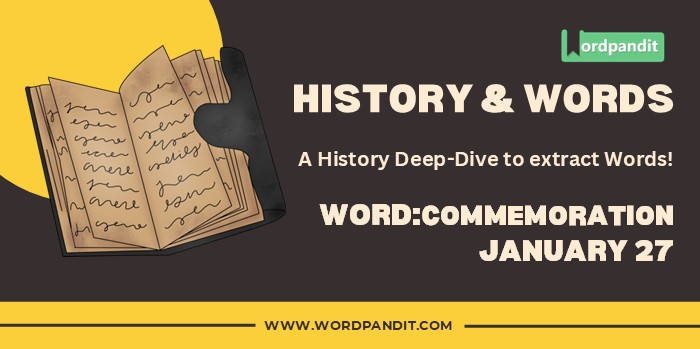History & Words: ‘Commemoration’ (January 27)
Welcome to ‘History & Words.’ 🌟 I’m Prashant, founder of Wordpandit and the Learning Inc. Network. This series combines my passion for language learning with historical context. Each entry explores a word’s significance on a specific date, enhancing vocabulary while deepening understanding of history. Join me in this journey of words through time.
📚 Table of Contents
🔍 Word of the Day: Commemoration
Pronunciation: /kəˌmɛməˈreɪʃən/ (kuh-mem-uh-RAY-shuhn)
🌍 Introduction
On January 27, 1945, Soviet troops entered Auschwitz-Birkenau, liberating more than 7,000 remaining prisoners from the largest Nazi concentration camp. This date would later become the International Holocaust Remembrance Day, exemplifying how significant historical moments transform into formal acts of commemoration.
The word “commemoration” carries profound weight in human society, representing our collective need to remember, honor, and learn from the past. It serves as a bridge between historical events and their contemporary significance, helping societies maintain their cultural memory and pass important lessons to future generations.
In the context of the Holocaust, commemoration takes on particular significance as both a moral imperative and a safeguard against the repetition of historical atrocities. It embodies the promise of “Never Again,” while serving as a tool for education, reflection, and social action.
🌱 Etymology
The word “commemoration” derives from the Latin “commemoratio,” combining “com-” (meaning “together”) with “memorare” (to remind, mention, or recount). This etymology reflects the communal nature of remembrance, suggesting that the act of commemorating is inherently collective, bringing people together in shared remembrance.
📖 Key Vocabulary
- 🔑 Memorial: A structure, space, or event designed to preserve the memory of a person or event, often serving as a focal point for commemorative activities.
- 🔑 Observance: The practice of following or carrying out a ritual, ceremony, or custom, particularly in relation to significant dates or events.
- 🔑 Testimony: First-hand personal accounts or witness statements that contribute to historical record and understanding, crucial in Holocaust commemoration.
- 🔑 Genocide: The deliberate killing of a large number of people from a particular nation or ethnic group with the aim of destroying that group, a term coined in response to the Holocaust.
🏛️ Historical Context
The practice of commemoration dates back to ancient civilizations, where monuments, ceremonies, and oral traditions preserved the memory of significant events and individuals. Ancient Egyptians built elaborate tombs and monuments, while Greek and Roman societies established regular festivals to honor historical moments and fallen heroes.
In modern times, commemoration has evolved to encompass diverse forms of remembrance, from national holidays and moments of silence to museums, educational programs, and digital archives. The 20th century, marked by unprecedented global conflicts and human rights violations, brought new urgency to commemorative practices.
The Holocaust fundamentally changed how societies approach commemoration. The systematic documentation of survivor testimonies, the preservation of sites of atrocity, and the establishment of educational programs created new paradigms for historical memory and commemoration.
⏳ Timeline
- 1945: Liberation of Auschwitz (January 27)
- 1947: Creation of first Holocaust memorials
- 1953: Establishment of Yad Vashem in Jerusalem
- 1978: President Carter creates US Holocaust Memorial Council
- 2005: UN designates January 27 as International Holocaust Remembrance Day
- 2011: Launch of UNESCO’s Holocaust Remembrance Project
🌟 The Day’s Significance
January 27 holds special significance as the date when Soviet troops liberated Auschwitz-Birkenau, revealing the full horror of the Nazi genocide to the world. The choice of this date for International Holocaust Remembrance Day connects the historical moment of liberation with the ongoing obligation to remember and educate.
The United Nations’ designation of this date in 2005 marked a crucial step in globalizing Holocaust remembrance. It established a universal framework for commemoration while acknowledging the unique nature of the Holocaust in human history.
The day serves multiple purposes: honoring victims and survivors, educating new generations, combating denial and distortion, and promoting human rights and dignity. It demonstrates how commemoration can function as both a backward-looking act of remembrance and a forward-looking tool for social change.
💬 Quote
“To forget the dead would be akin to killing them a second time.” – Elie Wiesel, Holocaust survivor and Nobel Peace Prize laureate
🔮 Modern Usage and Reflection
Today, commemoration extends beyond traditional ceremonies and monuments to include digital archives, social media campaigns, and interactive educational experiences. Virtual reality reconstructions of historical sites and online databases of testimony represent new frontiers in commemorative practice.
The challenge of maintaining meaningful commemoration in an age of information overload has led to innovative approaches that combine historical accuracy with emotional engagement. These efforts seek to make commemoration relevant to younger generations while preserving the solemnity of historical memory.
🏛️ Legacy
The evolution of Holocaust commemoration has influenced how societies remember other genocides and human rights violations. It has established principles of preservation, education, and witness testimony that guide commemorative practices worldwide.
The legacy of January 27 continues to shape international dialogue about human rights, discrimination, and the responsibility to prevent atrocities. It demonstrates how effective commemoration can serve as a catalyst for social change and moral education.
🔍 Comparative Analysis
While early Holocaust commemoration focused primarily on Jewish victims and European sites, contemporary practices have expanded to acknowledge all victim groups and promote universal lessons about human rights. This evolution reflects broader changes in how societies understand and use historical memory.
💡 Did You Know?
🎓 Conclusion
Commemoration, as exemplified by International Holocaust Remembrance Day, serves as a crucial bridge between past and present. It demonstrates how societies can transform historical trauma into constructive action while maintaining the dignity of victims and survivors. As we face new challenges to historical truth and human rights, the practice of commemoration remains essential for building more just and humane societies.
📚 Further Reading
- 📘 “The Holocaust and Collective Memory” by Peter Novick
- 📗 “Holocaust Memorials and Meaning” by James E. Young
- 📙 “Memory, History, and the Extermination of the Jews of Europe” by Saul Friedländer












